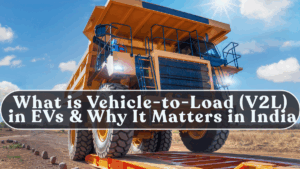As electric vehicles continue to rise in popularity, one of the most innovative features gaining attention is Vehicle-to-Load (V2L) technology. In simple terms, it allows an electric car to act as a portable power source, providing electricity to external devices, homes, or even other vehicles. For India — where power outages and outdoor lifestyles are common — this feature could redefine how people use their vehicles beyond just driving.

Understanding Vehicle-to-Load (V2L) Technology
The V2L feature in electric cars enables the car’s battery to discharge energy through standard AC outlets or external connectors. It transforms your EV into a massive power bank capable of running appliances, tools, and gadgets.
For example, during a camping trip, your electric SUV can power a coffee machine, laptop, or even a refrigerator. In urban scenarios, V2L can act as a backup power source for homes during blackouts.
-
Output range: Typically between 3.3 kW and 9.6 kW depending on the car model.
-
Connection types: Standard 220V sockets or Type 2/CCS connectors.
-
Operation: Works even when the car is not in “drive” mode.
This innovation turns EVs into energy hubs, offering both convenience and resilience.
V2L Adoption in India’s EV Market
While still new, several automakers in India have already begun offering V2L-capable EVs.
| Brand | Model | V2L Output | Key Feature |
|---|---|---|---|
| Hyundai | Ioniq 5 | 3.6 kW | Dual-way charging, outdoor plug socket |
| Kia | EV6 | 3.6 kW | Can charge other EVs or appliances |
| MG Motor | ZS EV (2024+) | 2.2 kW | Smart inverter-based discharge |
| Tata Motors | Curvv EV (upcoming) | 3.0 kW | Expected to support bidirectional power |
India’s early adopters have already showcased creative uses — powering home offices during outages, running food stalls, and charging e-bikes on road trips.
Benefits of V2L for Indian Consumers
V2L offers practical and financial benefits tailored to Indian lifestyles:
-
Backup power supply: Helps during grid failures, especially in rural or semi-urban regions.
-
Outdoor flexibility: Ideal for travel, events, and camping without generators.
-
Cost efficiency: Reduces dependency on diesel gensets and inverters.
-
Community support: EVs can share power during emergencies or natural disasters.
-
Energy independence: Encourages sustainable usage of stored clean energy.
With India’s frequent power interruptions, this feature could bridge the gap between mobility and energy resilience.
How Vehicle-to-Load Differs from Other Technologies
It’s important to distinguish V2L from related systems like V2G (Vehicle-to-Grid) and V2H (Vehicle-to-Home).
| Technology | Description | Application |
|---|---|---|
| V2L | Supplies power directly to appliances | Outdoor use, emergencies |
| V2H | Sends energy to a home circuit | Backup power for households |
| V2G | Exports electricity to the grid | Balances energy supply on a national scale |
Currently, V2L is the most consumer-friendly option since it requires no complex setup or government approval.
Challenges and Limitations in India
Despite its promise, V2L adoption faces a few barriers:
-
Lack of awareness: Many buyers are unaware of this feature’s potential.
-
Higher costs: V2L-equipped EVs are mostly premium models priced above ₹40 lakh.
-
Limited compatibility: Not all home or camping devices can handle high output power.
-
Policy gap: India has no official V2L or V2G regulation yet.
However, with falling EV costs and government focus on renewable integration, experts predict V2L features will soon trickle down to mass-market electric cars under ₹20 lakh.
Future of V2L in India
The coming years will likely see V2L become a mainstream standard. EV manufacturers plan to integrate dual-direction chargers and solar-compatible systems, allowing cars to store solar energy during the day and discharge it when needed.
India’s focus on “energy mobility” under Mission LiFE (Lifestyle for Environment) aligns perfectly with V2L adoption, promoting sustainable living practices. In disaster-prone areas, V2L-capable EVs could play a crucial role in powering relief operations.
Conclusion
The Vehicle-to-Load (V2L) feature represents a transformative step in India’s EV evolution — merging transport with portable energy. As awareness grows and costs drop, V2L could become as common as Bluetooth or fast charging. For Indian households, road-trippers, and small businesses alike, it’s more than just a feature — it’s a new way to power life using clean energy on wheels.
FAQs
What is V2L in electric vehicles?
V2L (Vehicle-to-Load) allows an EV to supply electricity to external devices, effectively turning it into a mobile power source.
Which cars in India offer V2L technology?
Currently, the Hyundai Ioniq 5, Kia EV6, and MG ZS EV (2024+) come with V2L capability.
Can I use my EV to power my house?
Yes, though only temporarily and for small appliances — true home backup needs V2H integration.
Does using V2L drain the EV battery quickly?
Power usage depends on load, but moderate use (like charging laptops or fans) has minimal impact on range.
Is V2L safe to use in India’s conditions?
Yes, provided certified connectors and adapters are used — all leading brands ensure IP-rated protection and smart cut-off safety systems.
